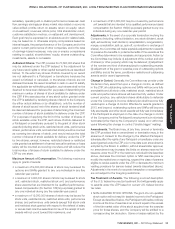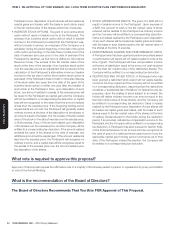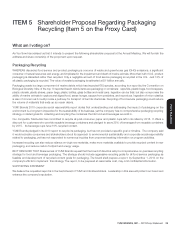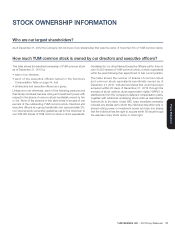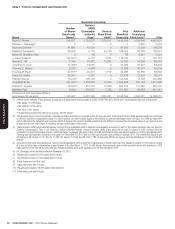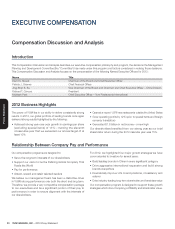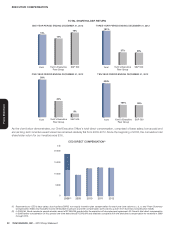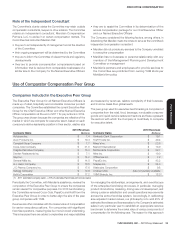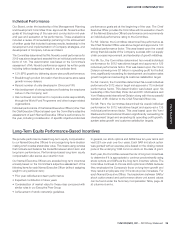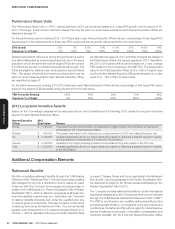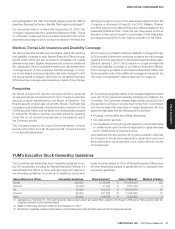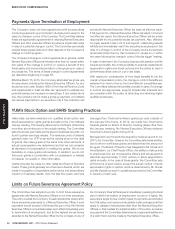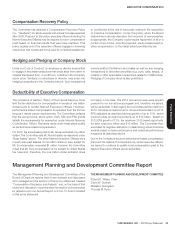Pizza Hut 2012 Annual Report Download - page 51
Download and view the complete annual report
Please find page 51 of the 2012 Pizza Hut annual report below. You can navigate through the pages in the report by either clicking on the pages listed below, or by using the keyword search tool below to find specific information within the annual report.
YUM! BRANDS, INC.-2013Proxy Statement 33
Proxy Statement
EXECUTIVE COMPENSATION
Shareholder Outreach and Engagement
At our 2012 Annual Meeting of Shareholders, over 70% of votes
cast were in favor of our Named Executive Offi cers’ compensation
program as disclosed in our 2012 Proxy Statement. While these
results represented a substantial majority support, we initiated an
extensive shareholder outreach program to better understand our
investors’ opinions on our compensation practices. Members of
our board of directors and management were directly involved in
this effort, including engaging in a dialogue with two proxy advisory
fi rms, to explain why we believe our pay for performance philosophy
has benefi ted shareholders over the long term. We appreciate the
feedback from our shareholders and the proxy advisory fi rms.
Changes Made After Committee Consideration of Feedback
After review and consideration of the shareholder vote and feedback,
the Committee unanimously approved and we made the following
changes to our compensation program for 2013:
•Updated the Company’s Executive P eer G roup to better align
the size of the peer group companies with YUM
•
Eliminated use of similar metrics in short-term incentive (“STI”) and
long-term incentive (“LTI”) programs by re-designing 2013-2015
performance share plan to measure relative total shareholder
return vs. the S&P 500
•
Increased use of performance criteria in LTI by changing the
CEO’s mix from 90% Stock Appreciation Rights and 10%
Performance Shares to 75% Stock Appreciation Rights and
25% Performance Shares
•
Discontinued Mr. Novak’s accruing nonqualifi ed pension benefi ts
under the Pension Equalization Plan (PEP) effective January 1,
2012 and, effective January 1, 2013, replaced his PEP benefi t with
a pension account determined under the Leadership Retirement
Plan. The Committee made this change to provide Mr. Novak a
long term benefi t that is similar to what he would have received
under PEP assuming historically normal interest rates, and to
provide him an annual benefi t amount that will not fl uctuate from
year-to-year due to interest rate volatility. Beginning in 2013, Mr.
Novak will receive an allocation to his pension account equal to
9.5% of his salary and target bonus and will receive an annual
interest allocation on his account balance equal to 120% of
the applicable federal rate. (See footnote (5) to the Summary
Compensation Table at page 45 for further details)
•
Consistent with the dominant governance model, eliminated
excise tax gross-ups upon a change in control for current and
future agreements and implemented double trigger vesting upon
a change in control of the Company for equity awards made
in 2013 and beyond
The changes described above reinforce our longstanding
commitment to an executive compensation philosophy that
emphasizes performance while at the same time is a direct response
to the feedback we received.
YUM’s Compensation Philosophy
YUM’s compensation philosophy for the Named Executive Offi cers
is reviewed annually by the Committee, and has the following key
principles:
•Reward performance
•Pay our executives like owners
•
Design pay programs that align team and individual performance,
customer satisfaction and shareholder return
•Emphasize long-term incentive compensation
•
Require Named Executive Offi cers and other executives to
personally invest in Company stock
Key Elements of Our Executive Compensation Program
•
Pay for Performance – The majority of Named Executive
Offi cer pay is performance based. We establish annual division,
corporate and individual performance targets designed to achieve
our annual EPS growth target of at least 10%.
•
Retain and Reward the Best Talent to Achieve Superior
Shareholder Results – To be consistently better than our
competitors, we need to recruit and retain superior talent
who are able to drive superior results. We have structured our
compensation programs to motivate and reward these results.
•
Long-Term Incentives are L inked to Our Shareholder Value
– Our belief is simple, if we create value for shareholders then
we share a portion of that value with those responsible for the
results. If no value is created then there is little or no reward from
our long-term incentive structure. Stock Appreciation Rights
and Performance Shares are designed to align the interests
of the Company’s executives with those of shareholders by
encouraging executives to grow the value of the Company.
•
Strong Stock Ownership Guidelines – We have always required
our Named Executive Offi cers (and top 600 employees) to
meet stock ownership guidelines. All Named Executive Offi cers
exceed their guidelines.
In addition, we have established the following policies for our programs:


